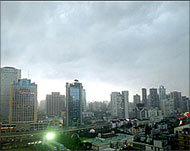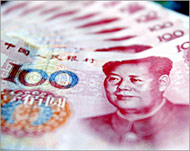Defining China’s evolving middle class
Sitting in his gleaming new Volkswagen Golf, Liu Yong speaks candidly about his good fortune.

“I took opportunities that were there and I succeeded,” he told Aljazeera.net. Starting off by selling pirate CDs and later DVDs to foreigners in the late 1990s, he earned enough to invest in a series of profitable real estate ventures.
“I think I have been successful,” he says circumspectly while navigating his way through the Beijing traffic, “but measuring success is so hard now as we always want more. When can you really say you have been successful?”
A quandary for some, but a recent report from the Chinese Academy of Social Sciences (CASS) may have helped shed some light on how to measure success in China’s changing society.
Definitions
Announced on the government run Xinhua news agency, the report decreed that 19% of China’s population could now be considered middle-class; a term that was ideologically taboo 15 years ago is now championed as a symbol of national modernity.
Defined through a family’s total asset valuation of $18,750 to $37,500, the announcement was accompanied by the announcement that China’s middle-class had grown by one per cent every year since 1999.
Potentially sweet news for the ears of foreign investors looking to sell their goods, Xinhua predicted that “thanks to favourable policies” the number of middle class people would rise to 40% by 2020.
However, while international news reports trended to focus on the 19% figure, little consideration was given to a report released in late January by CASS professor, Li Chunling.
 |
|
Urban incomes are five to six |
The CASS report used a wider range of categories including occupation, living standards, income and the individual’s subjective opinion.
Chunling surveyed 5860 people from across society and concluded that China’s middle-class numbered only about four per cent of the population.
Unwilling to be interviewed, it was unclear whether Li Chunling’s report was the same as the one cited by Xinhua.
In her report, the section concerning income gives no income-bracket figures but she calculates that from income alone, 24.6% of those surveyed could be considered middle-class.
Some estimates have calculated average urban incomes to be five to six times higher than rural ones.
Political repercussions
The apparent discrepancy in the two figures, brought about through differing formula, confirmed in experts’ minds that without clear indices, the term middle-class remains inherently political.
Symbolic of the publicity given by the government media to the 19% figure, “the middle-class issue is mainly a political one,” Gilles Guiheux, director of the French Research Centre on Contemporary China told Aljazeera.net.
“Middle classes mean social and political stability and that’s why everyone is so eager to find one in China,” he added.
|
“I think that inequality in society has become a top three priority for government leaders” Dr Kun Qinlin, |
The idea that China’s middle-class – however abstract its definition may be – is increasing provides statistical evidence that the government’s economic policies, and political legitimacy appear to be benefiting society.
At the same time, it helps taper concerns that the country faces a problem with economic polarisation.
“I think that inequality in society has become a top three priority for government leaders,” said Dr Kun Qinlin, a research fellow at Oxford University’s Institute for Chinese Studies to Aljazeera.net.
“While the 4.1% figure suggests polarisation, the 19% figure presents a rosier picture of that inequality, and it helps attract foreign investors,” he added.
After topping the world list in 2002 for foreign direct investment, last year’s figure of $57 billion was second only to the US.
Suggesting that the allure of China’s middle-class market still captivates, a figure of 4.1%, even though it factors in more than just income, would send out a less than inspiring message to company boardrooms.
Investor wariness
Even so, investor wariness is not a bad thing.
Famously, the early 1990s saw a frenzy of foreign investors pitching up in China hoping to seduce a then non-existent middle class with their products.
 |
|
Shanghai clearly has groups of |
“Everyone got burnt,” recalled Lilian Yap of Millward Brown, a consumer lifestyle research group. “Lots of people had the wrong strategy, but people are much more circumspect now about what the middle class means.”
Using the term middle class as a familiarising reference tool is useful she believes when looking at the visible group of wealthy consumers that populate the more developed cities.
According to APCO, a consultancy firm, those 19% of the population who apparently represent the middle class consume more than 80% of all resources – making them a tempting target for foreign branded products and services.
“If you look at the tier-one cities [Beijing, Shanghai], there are clear pockets of what could be called middle class, especially among the 20 to 45-year-old age range. It is in these key sectors that the reality of the Chinese purchasing power hits home,” says Yap.
Middle classers
Shopping most weekends with friends in Beijing’s clothing markets, 29-year-old Liu Ting represents the human end of the 19% statistic.
With family assets of between $18,750 and $37,500, she comfortably meets at least one definition of middle class.
“Such a label means nothing to me personally but it shows how China is modernising, how we are catching up with developed countries. If more people can be called middle class then it shows society is getting wealthier,” she says.
Generally spending cautiously, her own income of $850 a month does not allow for frivolous expenses but does provide for a mortgage on a small private apartment, something her parents never had at her age.
 |
|
The Chinese no longer wear |
“One of the most important aspects of this middle-class debate,” said Beijing University sociologist, Xia Xueluan, “is that people don’t mind saying they are wealthy. People’s value orientation has completely changed as in the past it was being poor that was glorious.”
“I don’t think my life is very difficult,” says 26-year-old Wu Yan. Another member of the middle-class club, her frugal lifestyle would not suggest she is seen as a key consumer.
Reinvesting much of her savings into English lessons at an international school, she still lives with her parents, despite the fact she has a husband.
“Does it really matter what class I am?” she asks. “I think my own dreams are very simple, a child, loving husband, big house and to study abroad.”
A lack of familiarity with the term was reflected in Chunling’s survey.
When people were asked for a subjective appraisal of their status, 46.8% believed themselves to be middle class, a factor Chunling put down to the absence of any recognised definition.
New category
“I am not sure what middle class means exactly as we grew up in a different system,” says property developer Li Yandong.
Describing himself as focussed, flexible and open-minded, he earns more than $2500 a month (eight times the average Beijing salary), owns a house and, until recently, a car.
Politically conscious, but wary of discussing an area that he cannot influence, Yandong is optimistic about the future.
“My generation feels a lot of pressure; we are straddling two worlds, between China’s past and future. I think the next generation will do better but we are lucky to have the opportunity to achieve.”
Technically indefinable without a consensus on measurement, the term middle class remains alien to a society that is still trying to grapple with such capitalist terminology.
Undoubtedly, there exists a wealthier group of people who would most likely be labelled middle class if such a term could be clarified. In the meantime, one can expect more contradictory statistics.